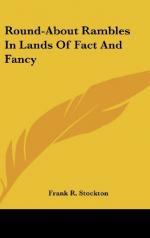That curious-looking pin with a Cupid on it is a lady’s hair-pin. The necklaces are in the form of serpents, which were favorite symbols with the ancients. The stands of their tables, candelabra, &c., were carved into grotesque or beautiful designs, and even the kitchen utensils were made graceful with figures of exquisite workmanship, and were sometimes fashioned out of silver.
Among the pretty things found in Pompeiian houses I will mention the following:—
A bronze statuette of a Dancing Faun, with head and arms uplifted; every muscle seems to be in motion, and the whole body dancing. Another of a boy with head bent forward, and the whole body in the attitude of listening. Then there is a fine group of statuary representing the mighty Hercules holding a stag bent over his knee; another of the beautiful Apollo with his lyre in his hand leaning against a pillar. There are figures of huntsmen in full chase, and of fishermen sitting patiently and quietly “waiting for a bite.” A very celebrated curiosity is the large urn or vase of blue glass, with figures carved on it in half relief, in white. (For the ancients knew how to carve glass.) These white figures look as if made of the finest ivory instead of being carved in glass. They represent masks enveloped in festoons of vine tendrils, loaded with clusters of grapes, mingled with other foliage, on which birds are swinging, children plucking grapes or treading them under foot, or blowing on flutes, or tumbling over each other in frolicsome glee. This superb urn, which is like nothing we have nowadays, is supposed to have been intended to hold the ashes of the dead. For it was a custom of ancient days to burn the bodies of the dead, and place the urns containing their ashes in magnificent tombs.
[Illustration: ORNAMENTS FROM POMPEII.]
Instead of hanging pictures as we do, the Pompeiians generally had them painted upon the smoothly prepared walls of their halls and saloons. The ashes of Vesuvius preserved these paintings so well that, when first exposed to the light, the coloring on them is fresh and vivid, and every line and figure clear and distinct. But the sunlight soon fades them. They are very beautiful, and teach us much about the beliefs and customs of the old city.
Lovely and graceful as were these pictures, the floors of the houses are much more wonderful. They are marvels of art. Not only are flowers and running vines and complicated designs there laid in mosaics, but pictures that startle with their life-like beauty. There are many of these, but perhaps the finest of all is the one found in the same house with the Dancing Faun. It represents a battle. A squadron of victorious Greeks is rushing upon part of a Persian army. The latter are turning to flee. Those around the vanquished Persian king think only of their safety, but the king, with his hand extended towards his dying general, turns his back upon his flying




